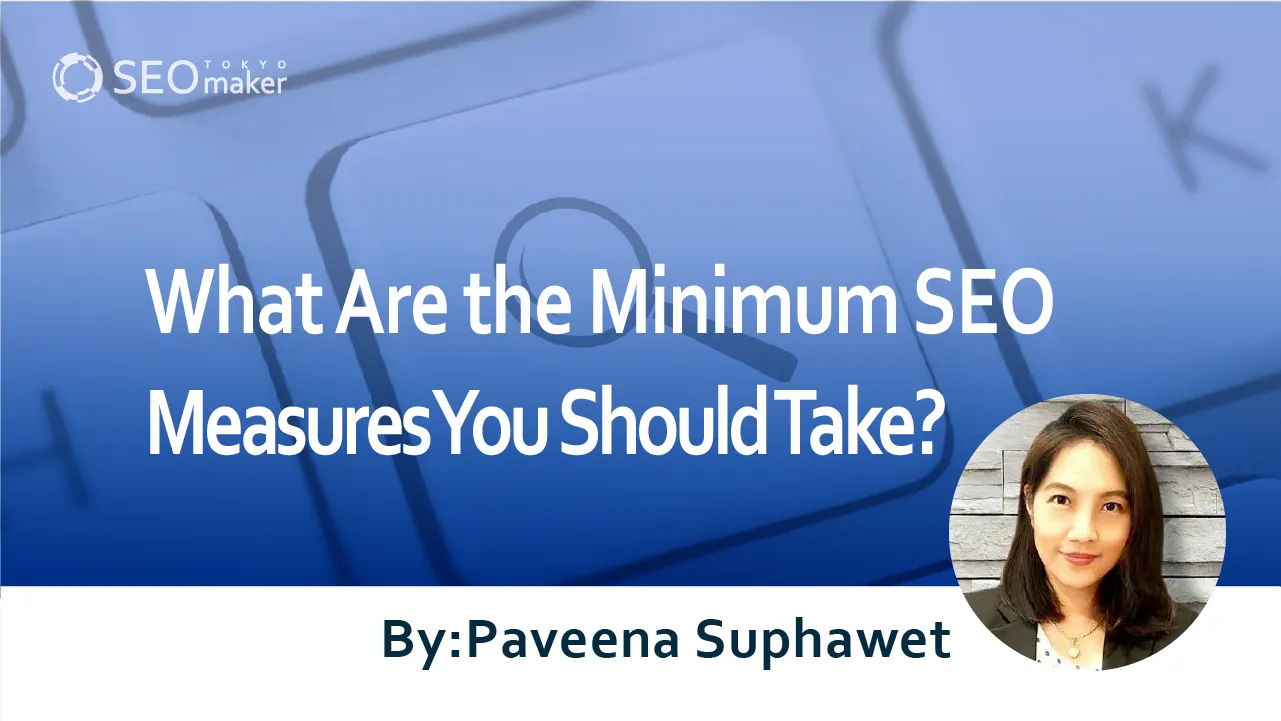What Are the Minimum SEO Measures You Should Take? :Recommended for Busy People
contents
- 1 Current State of SEO
- 2 Characteristics of Sites That Rank High
- 3 Minimum Essential SEO Measures
- 4 Summary

As the internet has expanded rapidly, various search engines have been developed. With the widespread use and significant influence of search engines, techniques for appearing at the top of search results, known as SEO strategies, have also become well-known.
In this article, we will introduce important SEO strategies based on questions from actual SEO consultation clients.
Current State of SEO
In the past, people used to say things like “just adding links will improve your ranking” or “just include keywords and you’ll be fine,” but that’s no longer the case.
Google continues to evolve rapidly.
After numerous major updates, Google’s search algorithm has become extremely sophisticated, making it vastly different from its early days.
As a result, half-hearted strategies based on hearsay might not only fail to produce results but could even cause your ranking to drop.
The person seeking consultation this time feels the need for SEO measures but hasn’t been able to take action due to time constraints.
Consultation: Want to take action but have no time…
About a year ago, I was asked to create a website for my parents’ business. They run a small, long-established hair salon in a local shopping district. Despite being a quick creation, the website turned out visually appealing, and my parents were very satisfied with it.
However, I recently searched for it and found that the website was not appearing quickly in the search results. I heard that ‘SEO measures’ could help, but I have a full-time job and can’t dedicate all my time to helping my parents. Is there any “minimum effort” SEO strategy that I can implement even with limited time?
Modern SEO strategies generally involve creating content diligently over time.
That said, there are strategies that can be effective with minimal effort if you know where to focus. Let’s go over some simple yet effective measures.
*Of course, for substantial results, thorough and consistent SEO efforts are necessary to align with current algorithms. The measures discussed here are meant to be “better than doing nothing.”
Characteristics of Sites That Rank High
When advancing SEO (Search Engine Optimization), understanding the characteristics of Google’s search engine is crucial.
By understanding these characteristics, you can naturally identify trends that make it easier for sites to rank higher.
The quickest way to understand Google’s characteristics is to thoroughly read Google’s SEO guidelines.
These guidelines are designed for various audiences and provide detailed information on Google’s recommended strategies and SEO practices. Understanding these will help you align with Google’s vision and strategies.
Google: Search Engine Optimization (SEO) Starter Guide
Google: Webmaster Guidelines
Considering Listing Ads
Listing ads are the small advertisements displayed in the search results. Advertisers pay Google a fee every time a user clicks on one of these ads.
If Google aimed to maximize revenue from fees, it might seem logical to fill search pages with these ads. However, that’s not necessarily the case.
Consider the user’s perspective.
If most of the search results are filled with ads, users may struggle to find the information they seek, leading to dissatisfaction.
Would you continue using a site under these conditions?
This scenario contradicts Google’s philosophy.
Larry Page, one of Google’s founders, said that “a perfect search engine accurately understands user intent and returns results that precisely meet their needs.”
By publishing SEO guidelines and encouraging site operators to improve content quality, Google aims to create a mutually beneficial search engine for users, site operators, and Google itself.
Google’s strategy focuses on long-term benefits rather than immediate profits. Therefore, SEO strategies should align with this forward-looking approach.
Conditions for Websites That Rank High in Search Results
Based on the above, let’s consider the conditions that make a site more likely to rank high in search results.
1.Sites that adhere to Google’s guidelines
Google’s guidelines outline the ideal direction for site management to benefit users. By following these guidelines, your site is more likely to be favorably evaluated by Google.
Additionally, the Webmaster Guidelines list discouraged practices (such as automatically generated content or hidden text). Reviewing these can help prevent unintentionally receiving penalties from Google.
2.Sites with content that users seek
Google recommends creating “unique, valuable, and engaging sites” in its guidelines.
Recently, sites that are easily evaluated tend to have original text content (text content that is not found on other sites that appear in the search results for the same keyword) or high-quality text content.
If the originality and quality are comparable, sites with more text on the page or more pages overall tend to be better evaluated. Review your site to ensure it contains content that your target users are looking for.
3.Sites that make it easy for Google to verify the content
Even if a site has highly demanded content, it must first be seen. Therefore, it is essential to have a site structure that makes it easy for Google to recognize the content. Only after Google recognizes the content can it begin to evaluate it.
4.Sites where users can quickly find and view the information they seek
If the information users are looking for is present but hard to find, it won’t be effective.
Clear navigation and fast loading speeds are crucial. For example, an ideal user flow is when a user visits the homepage, quickly sees the menu, and immediately understands, “Ah, this is the information I need!” and clicks on it. Additionally, if the page loads instantly when clicked, the user can continue browsing without any interruption.
If users can’t easily find the information they need or if the page loads slowly, they may leave the site. With the increasing number of mobile users, it’s also important to ensure your site is responsive and displays well on both smartphones and PCs.
Minimum Essential SEO Measures
Now, let’s look at the essential SEO measures you should take, even if you are short on time. If you are a complete beginner, it’s recommended to read “[2022 Complete Guide] What is SEO? The Latest SEO Guide [Strategies for Higher Rankings Explained]” before continuing with this page.Top of Form
Determining Keywords and Reflecting Them on Your Site
Before modifying your site, the first thing you need to decide on is the “keywords.”
If you already have a site and keywords decided, this might involve re-evaluating those keywords.
When users search on Google, they enter keywords into the search bar and review the results.
In an ideal but impractical scenario, your site would appear in the search results for every possible keyword. Thus, you need to narrow down your focus to specific keywords, deciding, “These are the keywords we’ll target.”
By narrowing down your keywords, you’ll also clarify the direction for site modifications and management. Having clear goals and direction from the start allows you to implement more effective strategies and use your limited time efficiently.
When deciding on keywords, the standard approach is to start with
- Main Keyword
Then, based on this, narrow down
- Related Sub-keywords (several)
How to Decide on Keywords
First, consider your target audience and research primary keywords that are likely to be searched.
A useful free tool for this is Google Ads’ Keyword Planner. This tool primarily helps advertisers find keywords with high search volumes for their ads, but you can also use it to research search keywords without running ads.
The results will show approximate monthly average search volumes like “1,000 ~ 10K” or “10K ~ 100K,” which is useful for identifying primary keywords.
Using such tools might be challenging initially.
Start by entering words that come to mind and observe the results. Over time, you’ll start to see patterns. Tools like these also suggest similar words you might not have thought of on your own, helping you discover optimal keywords.
Considering Search Volume
The higher the search volume for a keyword, the more users are looking for it.
However, choosing keywords with extremely high search volumes for your site might not be advisable, as it often means fierce competition.
Conversely, keywords with very low search volumes might not attract enough users (though niche keywords can sometimes be valuable for targeting specific audiences). Generally, avoid keywords with very low search volumes.
Search volume is crucial for understanding the keyword landscape.
However, the most important factor is identifying what your target audience is searching for and tailoring your strategy accordingly.
For example, since the site in question is for your parents’ beauty salon, a typical keyword could be “beauty salon [location].” The location could vary from state or city names, depending on the context. Choose keywords that best fit your specific situation.
The keywords you identify can be saved as a list. Keywords with “low” or “none” (indicated by a “-” symbol) search volumes are rarely searched. While some smaller keywords may lead to good results, generally, focus on keywords with moderate to high search volumes for efficiency.
Here are key points for refining keywords.
- Exclude clearly unnecessary keywords.
- Investigate unclear keywords.
About 1, exclude words that obviously don’t match your target audience.
About 2, for example, if you encounter the keyword “Australia study abroad vaccinations,” it may not be immediately clear what this means. However, upon investigation, you might find that it refers to the necessary vaccinations and related documentation required for studying abroad, and relevant web pages provide this information.
Keyword lists from tools like Keyword Planner are valuable resources. Reviewing them periodically can provide useful insights for future content creation.
Reviewing Site Structure Based on Keywords
Once you have decided on your keywords, the next step is to review your site structure. Align your site structure with the chosen keywords, aiming for one keyword per page.
Depending on your industry, pages such as company profile pages may also be necessary.
It’s particularly important to ensure that the site title and description are optimized for both Google evaluation and user comprehension. This can positively impact search results.
For search engines, content that users read should effectively incorporate keywords and reflect real-world context
In Google search results, the text under each webpage’s site title is called a “snippet.”
The summary of the content displayed in the snippet is known as the “description,” which is considered extremely important. Users who search for information typically read the description of the top-ranked pages and click on the one that best matches their search intent.
Therefore, the effectiveness of your description in responding to the user’s search keywords can significantly influence the user’s decision to click.
Especially with mobile devices, which have limited display space (generally within 50-60 characters), it is crucial to include important keywords in a concise manner without duplicating keywords across different content pages. It’s also effective to include specific numbers to catch the user’s eye (e.g., “20% cost reduction”). Even if the CTR (click-through rate) doesn’t increase, a strong description can improve conversion rates.
Ultimately, the content itself must be valuable to the user. A well-crafted snippet alone is not enough.
Properly Placing Links
There are several types of links you can use, including global and side menu links, as well as links within the content.
Google values links within the content more highly than those that are used site-wide. However, unnatural links may not only be ignored but could also result in penalties. Therefore, it’s important to place appropriate links where necessary.
There are several types of links to be used within content.
Examples include “reference links” for citing sources, “internal links” to guide users to other content within the site for additional explanations, and “CTAs (Calls to Action)” to prompt user actions.
To establish the credibility of an article, it is important to include reference links to research data published by reliable organizations.
Regarding internal links, Google seems to value “anchor text” links (links set within the text by a person) more highly than “site-wide links” that are commonly placed across the entire website. Links to related content can also contribute to increased time spent on the site.
A “CTA” is a button or link that encourages user actions, such as “Request Information” or “Add to Cart.” Placed appropriately, CTAs can be effective.
For example:
1.Placing one at the end of a blog post
2.Using it to connect to social media
3.A “Click to Tweet” link
Use them according to the situation can be effective, but be careful not to appear too pushy, as it can have the opposite effect.
Continuous Improvement and Addition of Existing Content
Google tends to favor sites that are regularly updated with new content. Therefore, it’s recommended to periodically add pages or content as you manage your site.
For instance, creating a series or a blog within your site and updating it with just one article per month can be a manageable way to continuously add content.
Timing for Improving Content
Even if a site is meticulously crafted, discrepancies between the actual situation and the content may emerge over the years. Design trends also change, so what was once cutting-edge may appear outdated after a few years.
Furthermore, user intent for the same keywords can shift over time. Utilizing tools like “Related Keyword Retrieval Tool” is necessary to follow these changes.
Therefore, it’s important to regularly improve and strengthen your existing content.
In rapidly evolving fields, the information covered in blogs can quickly become outdated. Regular updates to ensure that the content remains current are crucial.
Competitors are likely also improving their content as part of their SEO strategies. To avoid being left behind, you must continually enhance the breadth, depth, and uniqueness of your information.
Remember to update the date when you refresh content. However, avoid changing the URLs of existing content, as this can reset the accumulated value of the content.
Next, here are some key points on improvement and enhancement through adding content.
As you improve the initially created content, you will likely see gradual success. Don’t settle for these results; continually upgrade the scope and depth of your information. Consider the PDCA (Plan-Do-Check-Action) cycle to maintain and improve quality.
Besides improving existing content, consolidating multiple pieces of content into a single page can also be beneficial. This involves combining topics, correcting internal links, setting up “301 redirects,” and deleting unnecessary pages.
Additionally, from another perspective, improving and enhancing results by increasing trustworthiness is also an effective method.
Another approach is to improve and strengthen your site by enhancing trustworthiness.
Sometimes, focusing too much on SEO can make you overlook the importance of increasing touchpoints with users. Investigating the information users seek before and after purchasing products can be valuable.
Before purchasing, users primarily look for product features and prices, while post-purchase, they seek after-sales services and FAQs. Enhancing this information helps maintain user engagement and builds trust, which is as valuable as achieving SEO success.
Summary
Regularly checking SEO information, such as the “Webmaster Central Blog,” is a common strategy. By implementing these fundamental measures, you can maintain a continuous and positive relationship with users, ultimately leading to improved Google rankings. If you are struggling with improving your site rankings, please consult us. Our SEO professionals will analyze your situation and propose appropriate measures. Depending on the plan, you can also leave the task entirely to us.










![What is a Description? Explaining the Meaning, Writing Style, and Changing Word Count – [2023 Edition]](https://www.switchitmaker2.com/en/wp-content/uploads/2024/09/what-is-description.webp)










